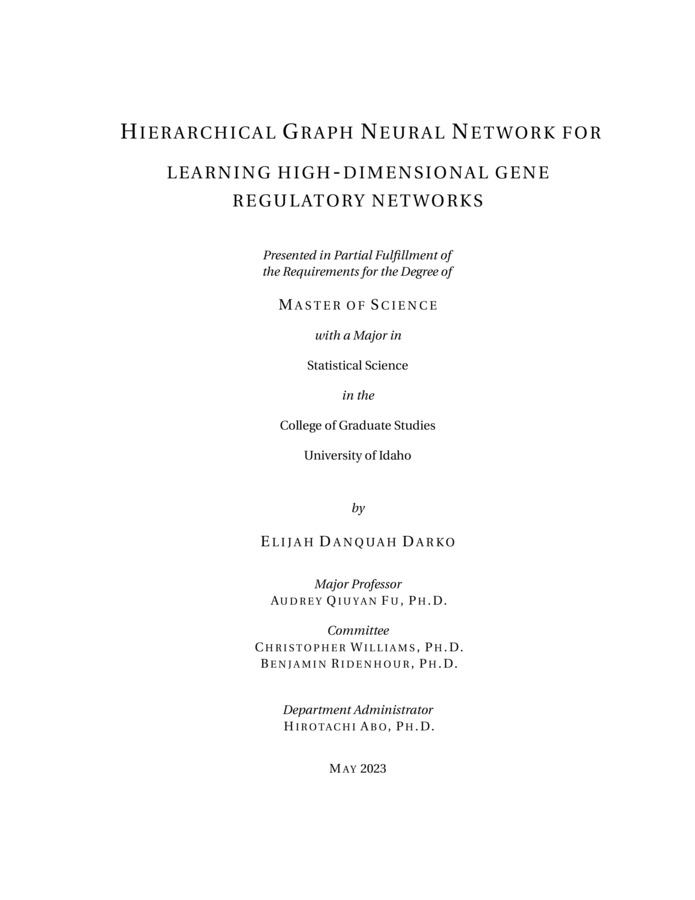Hierarchical Graph Neural Network for learning high-dimensional Gene Regulatory Networks
Danquah Darko, Elijah. (2023-05). Hierarchical Graph Neural Network for learning high-dimensional Gene Regulatory Networks. Theses and Dissertations Collection, University of Idaho Library Digital Collections. https://www.lib.uidaho.edu/digital/etd/items/danquahdarko_idaho_0089n_12600.html
- Title:
- Hierarchical Graph Neural Network for learning high-dimensional Gene Regulatory Networks
- Author:
- Danquah Darko, Elijah
- Date:
- 2023-05
- Program:
- Mathematics & Statistical Sci
- Subject Category:
- Statistics
- Abstract:
-
The study of Gene Regulatory Networks (GRNs) poses a significant challenge due to their high dimensions, making it difficult to accurately infer these networks for many genes. Moreover, it is also a challenge to interpret these networks or generate biologically meaningful hypotheses for further investigation. To address this issue, researchers often look for modules and pathways, which are subnetworks of much smaller sizes. This approach suggests an alternative to studying GRNs, which is to learn about a hierarchy of multiple layers of networks.
The idea behind this approach is to use a hierarchy of networks, with each layer building on the one below it. In this hierarchy, a node in an upper-layer network corresponds to a subnetwork in the lower-layer network. Therefore, the size of the networks in each layer increases from top to bottom in the hierarchy. This means that the bottom-layer network is the GRN at the gene level, whereas upper-layer networks group genes into subnetworks or networks of these subnetworks. This reduces the dimensions(number of nodes) as we move up the hierarchy and allows us to “zoom out” and look at the big picture. While this approach is similar to hierarchical clustering, it differs in that we are interested not only in the hierarchy but also in learning about the relationships among clusters at each level.
To address the challenges of inferring hierarchical GRNs from genome-wide data of molecular phenotypes (such as gene expression, DNA methylation, etc.), we present a deep learning algorithm, Hierarchical Graph Neural Network (HGNN). Our HGNN algorithm updates the inference on the hierarchy over iterations, in addition to updating the inference of the network in each layer. We utilize a four-component loss function that aims to recover the underlying network structure.
To assess the performance of this algorithm, we perform extensive simulations on two main datasets generated from a disconnected two-layer hierarchy and a connected three-layer hierarchy. By using HGNN, we aim to accurately infer hierarchical GRNs, allowing us to better understand the underlying biological processes and generate hypotheses for further investigation. Additionally, based on the results, HGNN has the potential to be applied to other datasets with high dimensions, offering a promising solution for studying complex biological systems.
- Description:
- masters, M.S., Mathematics & Statistical Sci -- University of Idaho - College of Graduate Studies, 2023-05
- Major Professor:
- Fu, Audrey
- Committee:
- Williams, Christoper; Ridenhour, Benjamin; Abo, Hirotachi
- Defense Date:
- 2023-05
- Identifier:
- DanquahDarko_idaho_0089N_12600
- Type:
- Text
- Format Original:
- Format:
- application/pdf
- Rights:
- In Copyright - Educational Use Permitted. For more information, please contact University of Idaho Library Special Collections and Archives Department at libspec@uidaho.edu.
- Standardized Rights:
- http://rightsstatements.org/vocab/InC-EDU/1.0/

